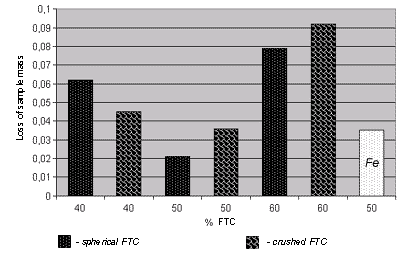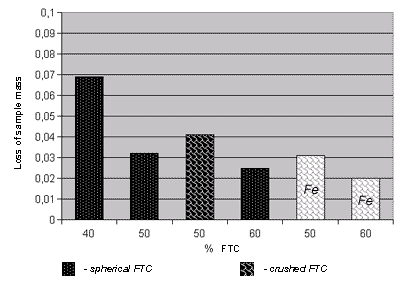|
Article: Author - Som А.I.
Today the composite alloys on basis of fused tungsten
carbide (FTC) [1, 2] are the most effective for surfacing
of the parts working in conditions of intensive abrasive
wear. Despite of its high prices, they are irreplaceable
in some cases, especially in metal mining industry.
Composite alloys are applied with success for surfacing
of such parts as locks of well tube, drilling bit
rolling cutters, excavator bucket teeth etc. [3-5].
Service life of parts, surfaced by these alloys, exceeds
durability of parts, surfaced by hypereutectic alloys
of type high-chromium cast iron a few times more.
Thereupon search of effective ways of surfacing of
the composite alloys providing the best combination
of service properties of surfaced metal is rather
actual. Among the known technological processes used
for surfacing of the composite alloys, especially
it is necessary to distinguish the Plasma
Transferred Arc surfacing (PTA-surfacing) [6].
It is the most suitable for these purposes as provides
high quality of surfaced metal, uses adding materials
in the form of powders and could be applied both in
mechanized, and in manual variants.
Present paper is devoted to research of a wear resistance
of surfaced metal, a dependence on quantity and forms
of reinforcing particles of FTC, a way of their input
in a welding pool, and also a type of matrix.
In experiments the powders from Ni- and Fe-base alloys
(tab. 1) are used as a matrix material. The fraction
of powders was 56-200 microns. A choice of these alloys
is not casual. Self-fluxing Ni-base alloys are widely
used for surfacing of composite materials. They have
rather low fusion temperature (1000-1100 °С), moisten
grains of FTC well and are enough wear-resistant.
The Fe-base alloy of the given chemical composition
is offered for these purposes for the first time.
It belongs to a class of high-vanadium cast irons
and combines high wear resistance with the plasticity
which is necessary for providing of resistance of
a working layer to impact load. Besides it is much
cheaper than Ni-base alloys.
As reinforcing materials the powders of crushed and
spherical FTC manufactured by Paton Welding Institute
are used. The sizes of particles of these powders
were within the limits of 100-300 microns.
The surfacing was carried out on samples of size
60х100х20 mm from steel 20 by plasma
torch РР-6-02 with the Plasma-Master
Co., Ltd. equipment (fig. 1). The section of deposited
bead was 25x5 mm, productivity of surfacing was 5
kg/h.
|

Fig.1. The PTA
system UPM-300 for surfacing of cylindrical
parts
|
Feeding of matrix and
reinforcing powders was carried out by two ways
- as a mix and separately. In the first case to
exclude separation, powders were mixed by confluence
of two streams feed from separate feeders, directly
before an input into plasma torch. In the second
- the matrix powder was feed in an arc through
central nozzle of plasma torch, and FTC - in a
welding pool directly through the special channel.
|
The purpose of feeding of FTC particles in a welding
pool was as much as possible to reduce thermal influence
of an arc thereby to protect them from dissolution.
Especially it is important when the Fe-base alloys
are used as a matrix [2, 3].
In table 2 there are all tested variants of surfacing.
A separate feeding was used mainly for spherical FTC,
as more perspective for this way.
The samples of size 16х16х6 mm for tests for wear
resistance and metallographic analysis were cut out
from surfaced plates. The top piece of a surfaced
layer of these samples were ground down to a level
at which FTC grains settled down relatively evenly
throughout section. Tests were carried out by machine
SR "stationary ring " [7]. The scheme of
tests is given below in the fig. 2, results of tests
are produced in the fig. 3.
Test conditions: abrasive - quartz sand in size of
particles 0,2-0,4 mm, length of friction is 400 m,
specific pressure of sample is 0,5 МPа, speed of sliding
of sample is 0,6 m/sec. Steel 45 was used as the standard.

Fig.2. The scheme
of wear resistance tests of samples:
1 - tested sample; 2 - rotating cross-arm; 3 - standard;
4 - water with an abrasive; 5 - copper ring; 6 - vessel.

a

b
Fig.3. The diagram of wear
resistance tests of samples. Numbers of alloys are
given in tab. 2.
a - way of powders feeding - mix; b - way of powders
feeding - separate.
Discussion of results
1. The surfacing by a mix of powders
The best results are achieved under the FTC content
in a mix about 50 volume % (variants 4, 5). It concerns
both to spherical, and to crushed FTC. Good formation
of beads and uniform distribution of FTC particles
throughout section (fig. 4) is provided in this case,
that in its turn provides the maximal wear resistance
of surfaced metal (fig. 3). If FTC in a mix is more
than 50 volume % then to form the bead well it is
necessary essentially (in 40-50 %) to increase surfacing
current, i.e. to increase heat-embedding into a part.
In its turn it results in appreciable dissolution
of particles, embrittlement of matrix and, as consequence,
in decrease of wear resistance.
In surfaced layer there is no more than 30 % spherical
and no more than 25 % crushed FTC on volume (fig.
5).
Under the FTC contents < 50 volume % (variants
1, 2) all it settles down in the bottom part of a
layer, leaving the unfilled top part. Naturally, wear
resistance of the top part, despite of some additional
alloying C and W, remains low (fig. 3).
|

a
|

b |
| Fig.4.
Distribution of spherical (a) and crushed (b)
FTC in surfaced layers under their contents in
mixes is 50 volume % (matrix - Ni-base alloy) |
|

a
|

b |
| Fig.5.
Distribution of spherical (a) and crushed (b)
FTC in surfaced layers under their contents in
mixes is 60 volume % (matrix - Ni-base alloy) |
Researches of distribution of matrix microhardness
throughout the height of a layer and micro X-ray spectrum
analysis show, that in all cases though to a variable
extent there is dissolution of carbides, at that it
is more appreciable in the top part i.e. in an effective
area of a plasma arc. Even in variants 4 and 5 with
50 volume % of FTC the matrix hardness grows from
HV01 366 kgs/mm2 at a fusion
line up to 727 kgs/mm2 in the top part due to alloying
by carbon and tungsten.
Microhardness of the kept particles of spherical
and crushed FTC in an alloy is approximately equal
and comes to 1850-1900 kgs/mm2. Microhardness of half-dissolved
particles changes within the limits of 1300-1600 kgs/mm2.
In all investigated variants there were microcracks
in a surfaced layer. Its minimum was in variants 4
and 5, and maximum was in 8 and 9. In variants 1 and
2 where the top part of beads was empty of carbides,
cracks settled down along a section border of the
layers (fig. 6, а)
|

a
|

b |
| Fig.6.
Arrangement of cracks in surfaced metal with incomplete
filling by carbides: a - surfacing by mix; b -
surfacing with separate powders feeding |
When using of spherical FTC because of high internal
pressure also there were scabbings of surfaced metal.
2. Surfacing by separate feeding of powders
Carbides dissolution during separate feeding of matrix
and reinforcing materials is minimal, even in case
of a Fe-base matrix (variant 12, fig. 7). It is confirmed
by the micro X-ray spectrum analysis data and microhardness
gaugings of matrixes. Microhardness of a Ni-base matrix
varies in limits HV01 360-420
kgs/mm2, on Fe-basis - within the limits of 540-640
kgs/mm2. Formation of deposited beads is good, cracks
are absent in most cases. They are observed similarly
to surfacing by a mix when there is a partial filling
of bead volume by carbides (variants 3, 6) (fig. 6,
b).
|

a
|

b |
| Fig.7.
Arrangement of carbides in a Fe-base matrix during
separate powders feeding: a - increase x20; b
- increase x100 |
Table 1.
Chemical composition of the alloys used as
a matrix metal
| Type
of alloy |
Content of elements, mass
%
|
Hardness, HRC
|
|
C
|
Si
|
B
|
Ni
|
Cr
|
V
|
Mo
|
Fe
|
Mn
|
| Ni-base |
0,5
|
2,6
|
2,2
|
base
|
13,5
|
-
|
-
|
2,1
|
-
|
40
|
| Fe-base |
2,2
|
0,6
|
-
|
2,7
|
18,2
|
7,8
|
2,5
|
base
|
0,8
|
44
|
Table 2.
Variants of realized surfacing and estimate
of wear-resistance
|
№
|
Type of matrix
|
Theoretical content of FTC,
volume %
|
Way of powder feeding
|
Form of FTC particles
|
Presence of cracks
|
Loss of sample mass during
friction, g
alloy = 2,5mm
|
|
Mix
|
|
Spherical
|
Crushed
|
|
1
|
Ni-base
|
40
|
Х
|
|
Х
|
|
+
|
0,062
|
|
2
|
--//--
|
40
|
Х
|
|
|
Х
|
+
|
0,045
|
|
3
|
--//--
|
40
|
|
Х
|
Х
|
|
+
|
0,069
|
|
4
|
--//--
|
50
|
Х
|
|
Х
|
|
-
|
0,021
|
|
5
|
--//--
|
50
|
Х
|
|
|
Х
|
-
|
0,081
|
|
6
|
--//--
|
50
|
|
Х
|
Х
|
|
+
|
0,058
|
|
7
|
--//--
|
50
|
|
Х
|
|
Х
|
+
|
0,106
|
|
8
|
--//--
|
60
|
Х
|
|
Х
|
|
+
|
0,079
|
|
9
|
--//--
|
60
|
Х
|
|
|
Х
|
+
|
0,092
|
|
10
|
--//--
|
60
|
|
Х
|
Х
|
|
-
|
0,028
|
|
11
|
Fe-base
|
50
|
Х
|
|
Х
|
|
+
|
0,055
|
|
12
|
--//--
|
50
|
|
Х
|
Х
|
|
+
|
0,042
|
|
13
|
--//--
|
60
|
|
Х
|
Х
|
|
-
|
0,031
|
Wear resistance of a Ni-matrix layer when uniform
its filling by carbides (variant 10) is close to value
which we had during the surfacing by mix (fig. 2).
When using the Fe-base alloy as matrix, it is a little
bit higher (variant 13).
As a whole, wear resistance of composite layers with
spherical FTC under other equal conditions is higher
than with crushed FTC. Spherical FTC is less dissolved
in a welding pool and is very convenient for PTA surfacing.
In the fig. 8 there are examples of surfacing by
composite alloys of real parts.
|

a
|

b |

c |
| Fig.8.
a - tooth of a crusher; b - chippers of a crusher;
c - calibration rollers; |
Resume
1. The best combination of service and technological
properties of metal both during surfacing by mix and
during separate feeding of powders is reached when
the contents of carbides in it is about 50 volume
%.
2. During separate feeding dissolubility of
spherical and crushed FTC is lower than during surfacing
by mix.
3. Qualitative surfacing by mix is possible,
however to avoid cracks and scabbings of surfaced
metal it is necessary to apply a matrix which is more
plastic and more neutral to carbides dissolution.
4. Using separate feeding of matrix and reinforcing
powders, successfully it is possible to apply as a
matrix the Fe-base alloys despite of losses of FTC.
|